#oldgodsinktober
Photo


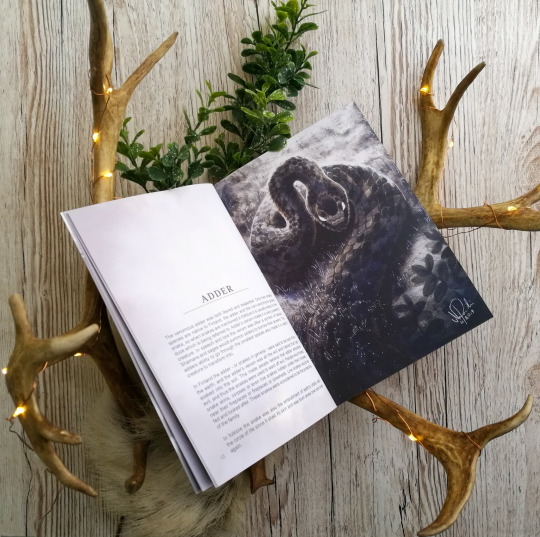
OLD GODS - Illustrations of Finnish Wildlife and Folklore is now up on Etsy!
OLD GODS is a collection of illustrations about Finnish wildlife and the myths and beliefs related to different animals. The artwork explores the mystical nature of many animals and portrays each as as ancient Finn could have seen them.
This zine features 33 ink illustrations, each accompanied by a written introduction to Finnish mythology and folklore related to the animals. The book also includes a step-by-step process for one of the paintings from start to finish.
I'm super happy with how this turned out and so proud that I was able to bring this project to life!
#old gods#oldgodsinktober#inktober#zine#art zine#art book#etsy#mythology#folklore#pagan#finnish mythology#ink painting#ink#traditional art#artists on tumblr
528 notes
·
View notes
Photo
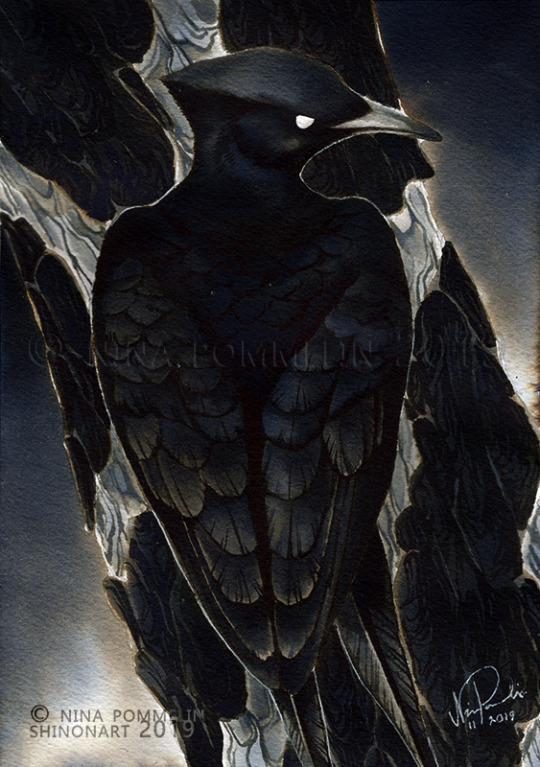
Old Gods: Day 28 - Black Woodpecker
In many stories the black woodpecker used to be a person who was turned into a bird after doing something bad or through an unfortunate event. Many of the beliefs about this bird have darker tones and so the black woodpecker is often associated with death and ill fate.
If a black woodpecker appeared near human settlements, or even worse, started pecking on the houses it meant a very grave situation. If you walk in the forest and follow a black woodpecker you will be led astray. If the bird flew in front of you someone close to you would die soon, but if it flew behind you it meant your end was near.
The black woodpecker predicted a lot of things, such as fire, famine or other disasters. However, if you listened to the bird's warnings these disasters would be possible to prevent.
People also believed that a straw from a black woodpecker's nest would be a magical key or a lock pick that was able to open any lock in the world.
#inktober#inktober 2019#inktober challenge#oldgods#oldgodsinktober#black woodpecker#woodpecker#animal art#bird#birds#bird art#mythology#finnish mythology#paganart#folklore#myths#traditionalart#artists on tu
488 notes
·
View notes
Photo
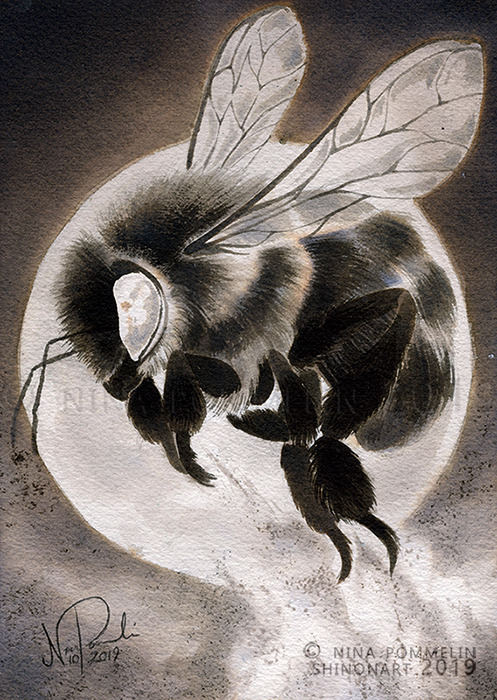
Old Gods: Day 2 - Bee
Honey was known to have healing properties and since bees make the honey they were seen as positive creatures, healers who bring wondrous medicine to the sick to heal many illnesses. In the Finnish national epic one of the heroes, Lemminkäinen, is torn apart and his pieces are cast into Tuonela, the river of death. His mother gathers the pieces and assembles her son. Finally, he is brought back to life by a bee who brings him the medicine.
According to some beliefs the bee is a messenger between the land of the living and the land of the dead.
You can follow along and use my prompt list if you like! If you want you can tag yours as #oldgodsinktober or #shinonart on all platforms so I can see your works, too!
#inktober#inktober 2019#oldgods#oldgodsinktober#bee#mythology#folklore#finnish mythology#pagan art#ink#ink painting#traditional art#traditional painting#artists on tumblr
586 notes
·
View notes
Photo
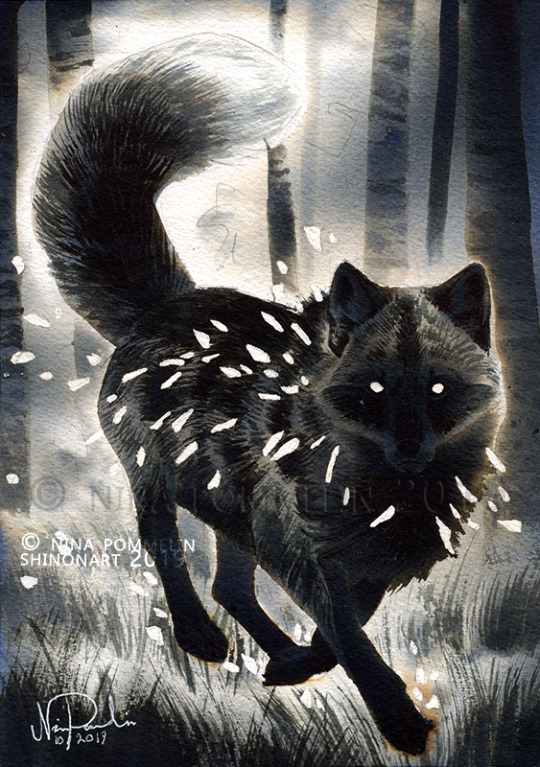
Old Gods: Day 19 - Fox
The fox is often associated with fire due to its red coat. In Finnish mythology each animals and plant has its "emuu", a guardian spirit, kind of an ancestor from which all animals and plants originate. The guardian spirit of the fox is called Käreitär who is also a spirit of fire. There are tales of a giant fire fox that is sometimes associated with the northern lights as well. Sometimes the mythical fire fox is a black fox. It is said that this fox runs in the forests and as its sides hit the tree trunks it sparks fire.
In some occasions the red coat was also associated with blood and so the fox was present in many spells that were used to close wounds. Sometimes the blood seeping from a wound was called with a name that had some association to the fox.
The fox was one of the most useful animals to shamans and sorcerers due to its speed and resourceful nature. It is maybe the most popular animal character in Finnish fables since it's very clever and cunning.
You can follow along and use my prompt list if you like! If you want you can tag yours as #oldgodsinktober or #shinonart on all platforms so I can see your works, too!
#fox black fox#animal art#mythology#finnish mythology#myths#paganart#folklore#oldgods#oldgodsinktober#inktober#inktober2019#inktober challenge#ink#ink painting#traditional art#traditional painting#artists on tumblr
451 notes
·
View notes
Photo

Old Gods: Day 12 - Horned Owl
The horned owl was considered a mighty fortune teller and in some occasions it was called the bird of Tuonela, the land of the dead. It was said to be the wisest and most clever of all birds even though owls in general were described as ugly and dumb.
The horned owl was the herald of all sorts of terrible things. If you heard its call it meant something bad was bound to happen. It could be war, bloody battles, murder, fires or famine. It could mean the death of someone important. Sometimes it might mean something smaller, such as a big snowstorms. Either way for these reasons the horned owl was hated and haunted for a long, long time.
You can follow along and use my prompt list if you like! If you want you can tag yours as #oldgodsinktober or #shinonart on all platforms so I can see your works, too!
#owl#inktober#inktober2019#oldgods#oldgodsinktober#paganart#mythology#finnishmythology#myths#ink#inkpainting#traditionalart#traditionalpainting#birds#birdart#artists on tumblr
472 notes
·
View notes
Photo

Old Gods: Day 11 - Frog
This fella is a toad but in Finnish mythology frogs and toads were basically the same thing. They were creatures of the underworld. Because toads have toxin in their skin they were associated with pain and disease. It was believed that frogs and toads are the reason why wounds inflicted by iron weapons caused so much pain.
Toads and frogs were associated with witchcraft, disease and even hurtful words. However, much like snakes they were also believed to be able to absorb poison and were kept near settlements for the same reason as people kept snakes. According to some beliefs the frog was a healer and a protector. A frog that was kept in the household was the protector of cattle and other animals and shielded them from harm and disease.
There are even mentions that frogs were related to humans. They were believed to be the descendants of people who had drowned in a great flood.
You can follow along and use my prompt list if you like! If you want you can tag yours as #oldgodsinktober or #shinonart on all platforms so I can see your works, too!
#frog#toad#amphibian#mythology#inktober#inktober 2019#inktoberchallenge#oldgods#oldgodsinktober#myths#paganart#traditionalart#traditionalpainting#artists on tumblr
480 notes
·
View notes
Photo

Old Gods: Day 26 - Lynx
The lynx is a nocturnal creature and very careful by nature so it was rarely seen meaning it rarely appears in Finnish mythology and folklore.Nocturnal creatures were often associated with the dark forces. The lynx was usually considered a very secretive and elusive creature. Sometimes it was thought of as a spirit rather than just an animal. In some occasions it was called “kave”, which meant either a forest spirit or basically any living creature in general. The lynx was thought as a creature that belonged to the forest, something that the forest kept as its own.
#oldgods#oldgodsinktober#inktober#inktober 2019#inktoberchallenge#lynx#ilves#mythology#myths#folklore#paganart#traditional art#traditional painting#artists on tumblr
339 notes
·
View notes
Photo

Old Gods: Day 25 - Pike
The pike was the most magical and important fish to shamans and sorcerers. It was believed that the pike was able to travel between realms by swimming to the bottom of a lake and all the way down to the land of the dead.
Pike parts were believed to have many magical qualities, especially jaws and teeth, which were believed to be a part of the creation of music. In Kalevala, the Finnish epic, the hero Väinämöinen makes a kantele (a type of string instrument) from a giant pike's jaw. It was said that the music Väinämöinen played with his kantele was so beautiful that it made even him tear up as he was playing.
You can follow along and use my prompt list if you like! If you want you can tag yours as #oldgodsinktober or #shinonart on all platforms so I can see your works, too!
#pike#fish#animal art#inktober#inktober 2019#oldgodsinktober#oldgods#finnishmythology#mythology#folklore#myths#paganart#traditionalart#inkpainting#traditionalpainting#artists on tumblr
353 notes
·
View notes
Photo

Old Gods: Day 16 - Arctic Fox
White animals were thought to be something special, magical, mythical. The arctic fox was considered a very mythical creature due to its coat that turned pure white in winter.
The arctic fox was also called the fire fox. The tales tell that when the fire fox ran across the snowy fells sparks were born from its feet and those sparks became the Northern lights. In Finnish language the auroras are called "revontulet" ("repo" being another name for fox) which literally means "fox fire".
You can follow along and use my prompt list if you like! If you want you can tag yours as #oldgodsinktober or #shinonart on all platforms so I can see your works, too!
#arctic fox#fox#foxes#inktober#inktober 2019#oldgods#oldgodsinktober#mythology#myths#finnishmythology#paganart#folklore#inkpainting#ink#traditionalart#traditionalpainting#artists on tumblr
392 notes
·
View notes
Photo
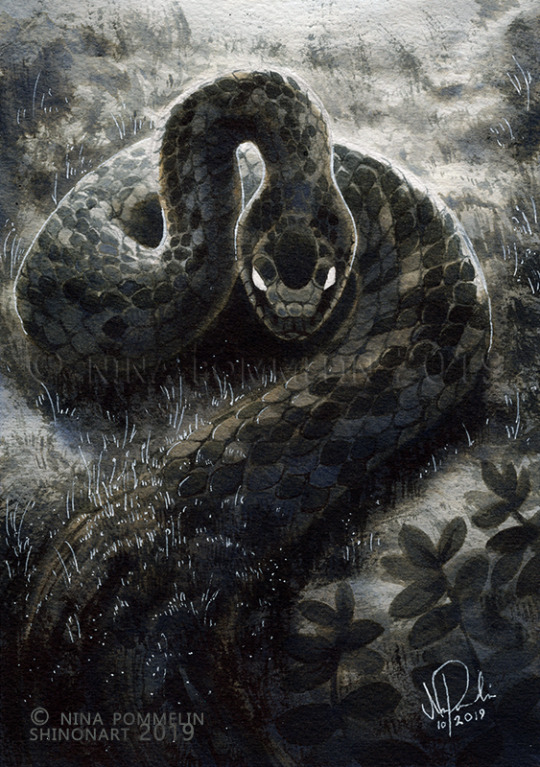
Old Gods: Day 7 - Adder
The venomous adder was both feared and respected. Folklore and mythology usually talks about a generic "snake" but since Finland only has two native species of snake, adder and grass snake, it didn't really matter much. Adder's venom made it a very powerful creature. Sometimes the venom was a symbol or equal to hatred in speech and lore. Shamans and sorcerers would summon adders for their aid to use their powers. The adder was also a very useful creature to transform into due to being able to go through the smallest spaces.
In Finland the adder - or snakes in general - were said to be born from the earth and the venom in adders was all the evil and hatred that had soaked into the soil. This made people believe that adders could absorb evil and hence the snakes were used to ward off evil. People would keep snake skins, snake corpses or even live snakes hidden under their houses, near their fireplaces or cowsheds and they would feed the live snakes. These snakes were the protectors of each family.
The snake was the embodiment of earth's vitality and the circle of life since it shed its skin and was born anew over and over again.
You can follow along and use my prompt list if you like! If you want you can tag yours as #oldgodsinktober or #shinonart on all platforms so I can see your works, too!
#snake#snakes#reptiles#inktober#inktober 2019#oldgods#oldgodsinktober#ad#kyy#ink#inkpainting#mythology#myths#folklore#pagan art#artists on tumblr#finnish mythology
424 notes
·
View notes
Photo
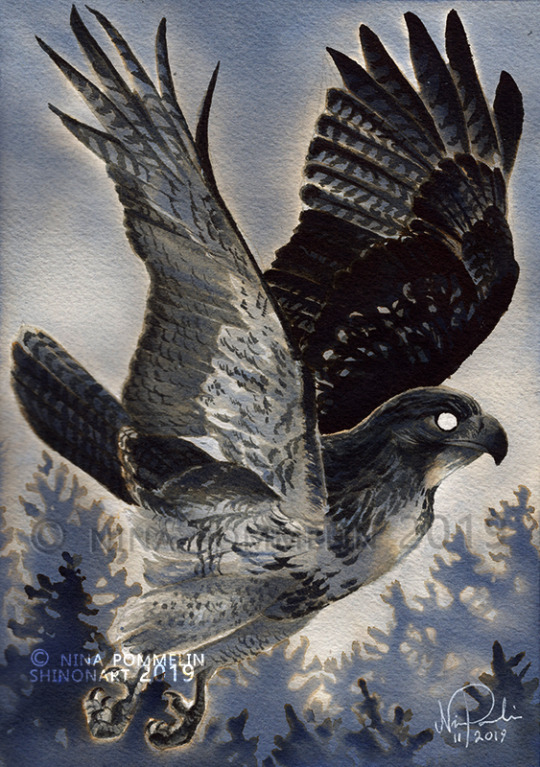
Old Gods: Day 31 - Hawk
The hawk was an otherworldly creature, powerful just like the eagle. There was even a precise measure to tell how otherworldly the hawk was. It was believed that nine tenths of a hawk was supernatural. The hawk was called for help when people needed to borrow its strength to do great things
Like many other birds the hawk also predicted death, and in some occasions it was referred to as the devil's bird.
Despite the association to death and evil powers people would still believe that the hawk's power would protect their possessions. A common custom was to hang a dead hawk with its wings spread out above the barn or stable door so no jealous soul or disease would touch the animals.
That's it! I finished the entire prompt list. Thank you all for following along, and I hope you enjoyed it! I’m gonna put all of these paintings together into a small art book very soon so stay tuned! the book will also contain the myths and beliefs tied to each animal so it’ll be a nice little package of information and inspiration!
#inktober#inktober 2019#inktober challenge#oldgods#oldgodsinktober#hawk#myths#mythology#folklore#finnishmythology#paganart#painting#inkpainting#ink#traditional art#artists on tumblr
252 notes
·
View notes
Photo
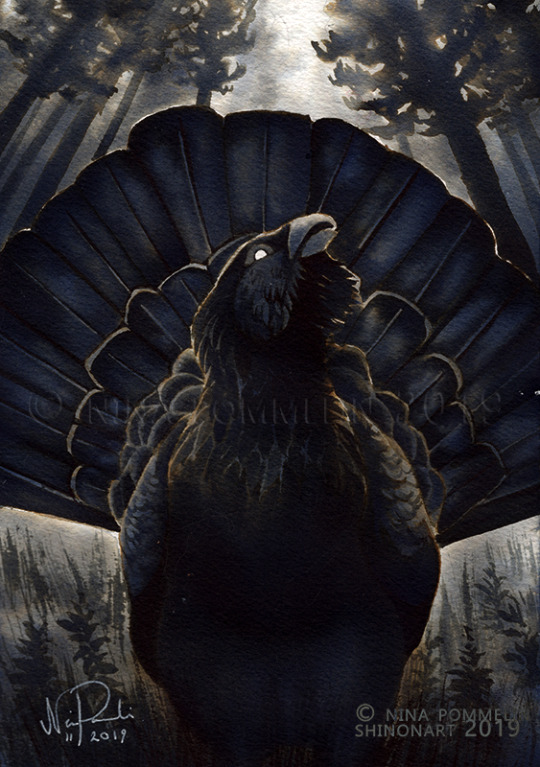
Old Gods: Day 29- Wood Grouse
As the name already suggests the wood grouse was strongly associated the forest, so much in fact that it was basically synonymous with the forest. The Finnish name, metso, is almost the same as the Finnish word for forest, metsä. The wood grouse doesn't migrate and it rarely leaves the forest and so seeing a wood grouse near human settlements was considered an ill omen. The wood grouse was a herald of war, famine and death.
The wood grouse is a very powerful, magical bird, and it was said to be the king of the forest and all animals dwelling in it (despite the bear, moose and crane also being called kings of the forest/other animals). Shamans would often take the form of a wood grouse. According to some beliefs, if you shot a wood grouse with a silver bullet what falls down would not be a bird but a witch.
However, despite all the ill omens and witchcraft, one shouldn't shoot a wood grouse or try to drive it away as it will always backfire and shooting a wood grouse will make the shooter go blind.
#wood grouse#metso#finnishmythology#myths#mythology#paganart#folklore#inktober#inktober 2019#inktober challenge#oldgods#oldgodsinktober#traditional aboriginal art australia#inkpainting#traditionalpainting#traditionalartist#artists on tumblr
251 notes
·
View notes
Photo

Old Gods: Day 22 - Seal
According to a tale the seal was born when a swallow's egg fell from a ship into the sea and broke into fish and seals.
The seal was important to ancient Finns mostly because it was a valued quarry so there are very few beliefs or myths related to it. It was both a symbolic and a concrete sign of wealth in the waters, but also a competitor who was after the same prey as humans, fish. People would avoid calling quarry by their real names since doing so would bring bad luck with hunting. Due to this the Finnish word for seal, "hylje", most likely derives from the verb "hylätä", to abandon, because it was considered more safe to say that the sea had abandoned and surrendered the animal to humans rather than begin killed by humans.
Even without much mythology tied to the seal the animistic traditions were strong. According to animism all animals were thought to have souls and thus were thought to be like humans. All animals were worthy of respect, even and especially prey because people's livelihood depended on them.
You can follow along and use my prompt list if you like! If you want you can tag yours as #oldgodsinktober or #shinonart on all platforms so I can see your works, too!
#seal#saimaannorppa#inktober#inktober2019#inktoberchallenge#oldgods#oldgodsinktober#traditionalattire#traditionalpainting#mythology#paganart#folklife#finnish mythology#artists on tumblr
369 notes
·
View notes
Photo

Old Gods: Day 15 - Wolf
The wolf was treated differently than most animals. While it was a creature whose great power was recognized it was also a threat and competition to people. Many beliefs were related to how to get protection against wolves. There are many spells and many rituals that were believed to protect people and livestock against wolves. Wolf heads would be hung near pastures to repel the wolves and iron scythes were often hung above barn doors so that when the animals passed under the iron blades they gained protection against wolves.
Interestingly enough the wolf was believed to have been a part of the creation of iron. When a wolf ran across marshlands iron would sprout from the wolf tracks. If people found wolf tracks in the swamp they would dig up the paw prints and turn them the other way around to repel wolves.
The wolf was a typical animal that shamans and sorcerers borrowed power from. There are also stories about werewolves and in Finnish mythology they were born either from free will, through a curse or some taboo related to childbirth and pregnancy. Wolves were strongly associated with womanhood and one of the best known werewolf stories in Finland is called "The Wolf's Bride".
The wolf shares many qualities with humans, such as tightly knit packs, social intelligence and adaptability, even the melancholic songs. Despite the similarities the wolf has always been seen as a creature of the wilds, the soul of forests.
You can follow along and use my prompt list if you like! If you want you can tag yours as #oldgodsinktober or #shinonart on all platforms so I can see your works, too!
#wolf#wolves#canine#inktober#inktober 2019#oldgods#oldgodsinktober#mythology#good mythical summer#paganart#finnishmythology#folklore#traditionalpa#traditional art#artists on tumblr
334 notes
·
View notes
Photo
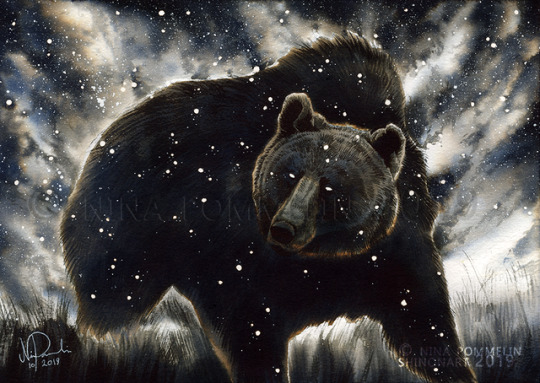
Old Gods: Day 9 - Bear
The bear was arguably the most important and respected animal to ancient Finns. It was basically a deity. It was believed that humans were descendants of this deity, both ate the same things, could stand on two feet and shared the same wisdom and emotional intelligence.
The bear was believed to have come from the sky. When it set foot on earth it was warned not to ever harm humans. It did, however, and as a punishment the bear was beheaded and sent back to the sky. This is the origin of the Big Dipper constellation.
There were numerous rituals and beliefs related to bear. After succesfully hunting down a bear it received a ritual like no other in its honor. The purpose of this ritual was to give the bear a proper farewell before it was sent back to the sky where it came from. The ritual went through the bear's entire life, from birth to death, and was often staged as a wedding which reflects the bond between human and bear and their origin story.
The bear is still the most important animal to Finns. It is the national animal of Finland and since 2014 "Karhun kansa" (Bear's Folk) has been a legitimate religion in Finland.
You can follow along and use my prompt list if you like! If you want you can tag yours as #oldgodsinktober or #shinonart on all platforms so I can see your works, too!
#bear#oldgods#oldgodsinktober#inktober#inktober 2019#ink painting#traditional art#traditional painting#folklore#pagan art#mythology#myths#finnish mythology#artists on tumblr
336 notes
·
View notes
Photo
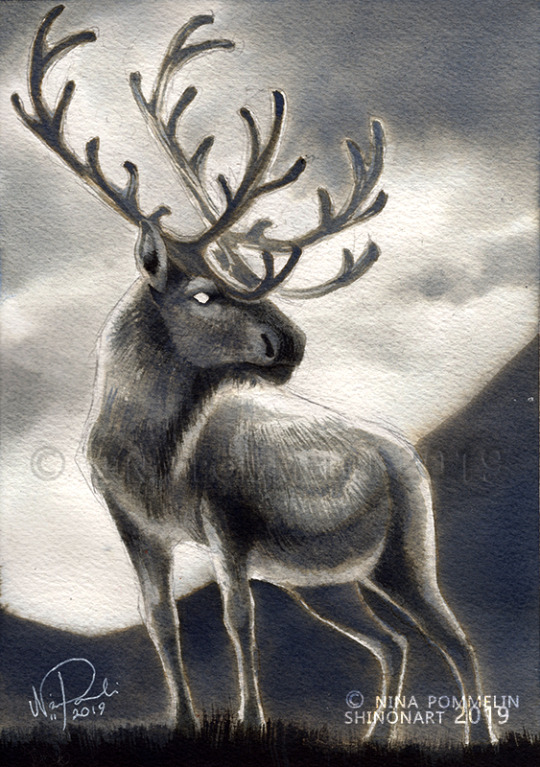
Old Gods: Day 27 - Reindeer
The reindeer has always been a very significant animal, especially in Sami people's religion. The reindeer was one of the most important quarries, and in order to make sure the hunts were successful and that the herded animals there were a lot of rituals and beliefs related to reindeer that would bring good fortune. In one such ritual the bones of a reindeer that was found dead were preserved, laid on the ground and arranged anatomically correctly and protected from predators.
The reindeer were more than just quarry. They were believed to be otherworldly creatures and their antlers had magical qualities. It was believed that in the realm beyond the reindeer had a leader that could take the form of a reindeer or a human.
One of the most popular beliefs was related to white reindeer. A white male reindeer was believed to be the lord of all animals and a white female was considered to be a creature of great fortune. Having a white female reindeer in the her would keep the herd healthy prosperous.
#reindeer#deer#inktober#oldgodsinktober#oldgods#inktoberchallenge#inktober2019#mythology#myths#folklore#paganart#finnishmythology#artists on tumblr#traditional a#traditional painting
208 notes
·
View notes